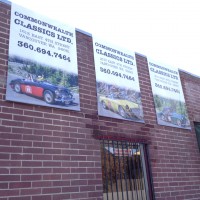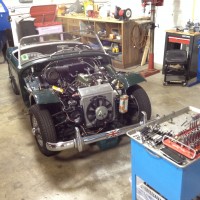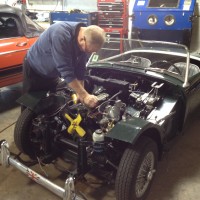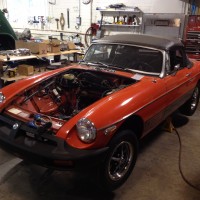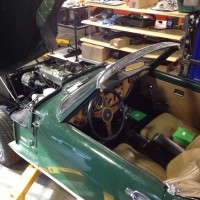It was just two months ago that I bought Bradley his first car, a 1960 Bugeye.
I drove the “needs-nothing” car home 65 miles from White Salmon, WA, made a short list of minor items in need of attention and gave Bradley a ride around the block.
The car didn’t idle well, so I sent it to Commonwealth Classics, owned by SCM contributor Reid Trummel, in Vancouver, WA. Surely, I thought, it just needs a little tweaking and will be better than new.
A few days later, the note arrived from Reid explaining why the Sprite needed a new engine and suspension.
I wondered why he hadn’t used the form letter all the other shops use when they examine one of my new acquistions. They all say the same thing: “Keith, after careful examination, we’ve found out that your (insert year, make and model of car here) needs everything. Please send us your debit card to keep on hand, as we will need frequent infusions of cash.”
As you can see from the detailed notes below, this shouldn’t be an especially expensive proposition. And it proves once again that unless you buy your car with paperwork from a shop whose name you recognize, you should simply assume that you’ll have to do everything.
Sports cars from the ’50s and ’60s were never thought of as having potentially long lives. That means today, as their values continue to increase, we are treating them properly for the first time in decades. Frankly, 30 years ago I would have dealt with one cylinder that was low on compression by simply installing a hotter spark plug in that cylinder. A hotter plug won’t foul as easily if oil is getting past the rings. Today, I’ll have the engine rebuilt.
Here’s the note from Commonwealth Classics:
1. According to Bob McKee, the general manager, the oil pressure looks reasonable at 20 lbs +/- at idle.
The rear main may be leaking, but there is so much oil on the engine it’s hard to tell where it’s coming from. It may be just blow-by coming out of the vent tube near the rear of the block.
Depending on the budget, it’s worthwhile to replace the rear main seal, oil pump, main and rod bearings, etc. while we do the rings — basically overhaul the lower end of the motor with the exception of replacing the pistons unless they are badly worn.
And of course “while we’re at it” inspect and rebuild or replace any other questionable parts; really anything that can best be done while the engine and transmission are out should be looked at. It will save money in the long run not having to do things twice.
2. The repair of the carbs would be a huge improvement. In my opinion, to make the car a runner, two things need to happen. The carbs being one, the other being the rings. The lack of compression in cylinder 2 will cause the motor to run rough and also, with the amount of blow-by, will cause the oil to “burn.” Plus the oil that is escaping though the vent tube will continue to get worse. That’s how I would proceed.
3. I’d recommend doing the safety items as well, so:
1) Replace tie rods:
Tie rods $165.00 x 2=$230.00
Rack boots $12.59 x 2 =$26.18
Labor $150.00 +/-
Total $406.18 +/-
2) Replace brake rotors:
Rotors $20.00 x 2=$40.00
Labor $75.00 (less if done with tie rod replacement)
Total $115.00 (or less)
Next would be drivability issues:
1) Replace or rebuild carburetors
A) Replace with used carbs, $300
B) Or – Rebuild existing carbs, $550.00 + shipping
C) Or – Replace with new carbs, $800.00 + shipping
Labor to remove, replace & adjust $150.00 +/-
Total $150.00 +/- plus A, B or C above
2) Low compression on #2 cylinder, excessive smoke & oil consumption
Replace rings on #2 piston (actually all four)
Parts:
Ring set $67.00 (set of four, can’t buy just one)
Gaskets $40.00
Oil filter $8.00
Oil $34.95
Labor $450.00
Total $599.95. This is the lowest cost way to do this, but isn’t recommended. This only covers removing the engine, removing the head and sump, honing the cylinders, replacing the rings, reassembling the engine and replacing it in the car. If some other component (main bearings, oil pump, rear main seal, etc.) needs to be replaced in the future, most of the labor costs will be repeated.
3) Front suspension rebuild
Major rebuild kit, $250.00
Machine shop work, $100.00
Labor, $300.00 – some of this labor cost is repeated from the tie rod replacement.
Total $710.00
4) Transmission
This is an unknown, recommend driving to determine when the popping-out-of-gear problem occurs and to see if there any other problems with the transmission, clutch or drive line.
Rounding up (you never round down with a repair estimate), this looks like about a $3,000 bill, which means it will probably come in at less than $5,000.
For that amount, I’ll have a car that is mechanically renewed and will be ready to last a lifetime, especially at the 2,500 miles per year it is likely to be driven.
That means that right now I have four cars in the shop: the 1965 Alfa Romeo Giulia Spider Veloce, the 1961 Giulietta Sprint Speciale, the 1967 Volvo 122S and the Bugeye.
Isn’t it nice that SCM provides such guaranteed full-time employment for classic car repair shops?
Without doubt, there will be more to read on this topic in the future.
